

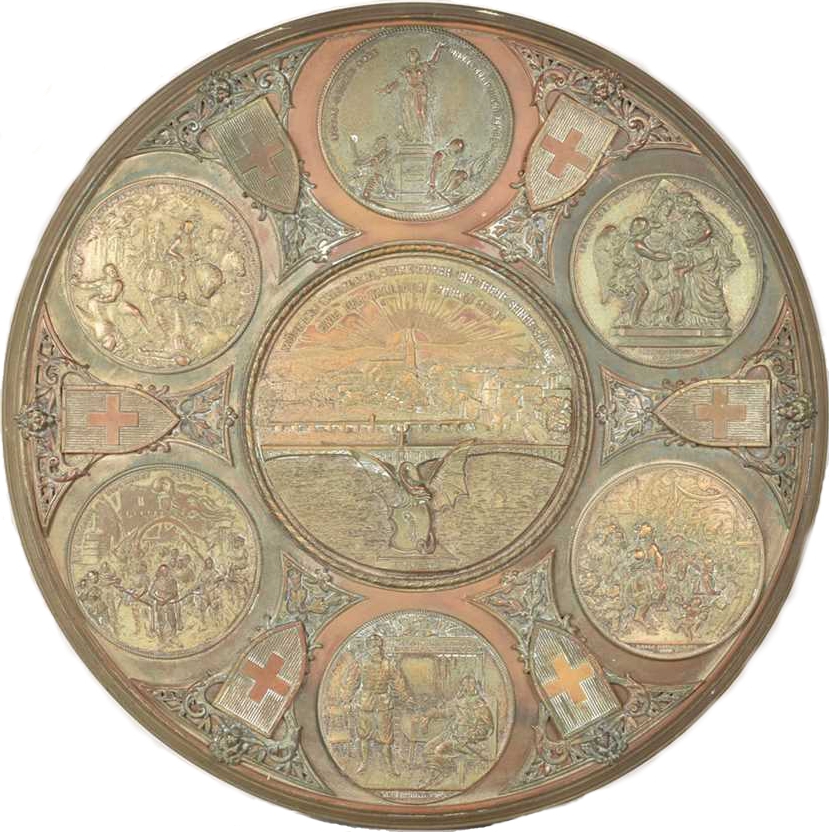
Today, Basel, stands out as a great city for several reasons:
1. Cultural Capital of Switzerland
- Art and Museums: Basel has over 40 museums, including the world-renowned Kunstmuseum, Fondation Beyeler, and Tinguely Museum. It's also home to Art Basel, one of the most prestigious contemporary art fairs globally.
- Architecture: The city boasts striking architecture, with buildings by Herzog & de Meuron, Renzo Piano, and Zaha Hadid.
2. Location and Internationalism
- Tri-border Region: Basel sits at the junction of Switzerland, France, and Germany, giving it a cosmopolitan feel and easy access to other European cities.
- Multilingual and International: Many residents speak multiple languages, and the city hosts a multitude of headquarters of global companies and institutions like Roche, Bank for International Settlements, Novartis, and many more
3. High Quality of Life
- Public Transportation: Basel’s trams and trains are efficient and clean.
- Bicycle friendly: everywhere in Basel is accessible by bicycle.
- Safety and Cleanliness: Like most of Switzerland, Basel is very safe and well-maintained.
4. Science and Innovation
- Home to Switzerland’s oldest university (University of Basel), the city is a hub for research, especially in life sciences and pharmaceuticals.
5. Unique Traditions
- Basler "Fasnacht" (Carnival): A UNESCO-recognized Carnival event, it’s a unique 3 day cultural experience that draws visitors from all over.
- Floating down the Rhine: A summer tradition where people float down the river with waterproof bags containing dry clothes called Wickelfisch.
6. Amazing Sport Niveau
- FCB Football Club Basel plays at the top levels, and often rises high within the Champions League
- Womans EURO soccer championship is in Basel in 2025
- Longines World Cup Horse Jumping and Dressage events take place in Basel
- Basel is Rodger Federer's home town
We thought it would be interesting to look at Basel in 1901 - at the 400th anniversary of Basel joining the Swiss Confederation to see what people thought was historically important then, compared to the massive powerhouse of Industry, Finance and Culture that Basel has now become.
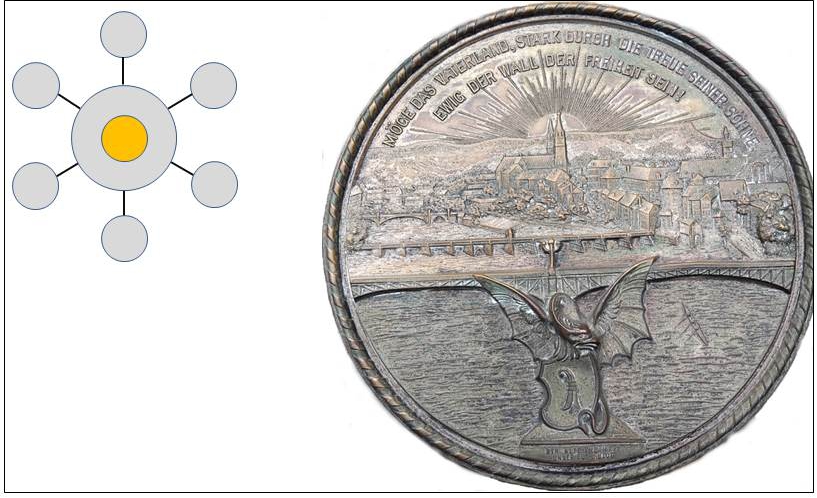
MÖGE DAS VATERLAND, STARK DURCH DIE TREUE SEINER SÖHNE,
EWIG DER WALL DER FREIHEIT SEIN!
MAY THE FATHERLAND, STRONG THROUGH THE TRUTH OF ITS SONS, FOREVER BE THE WALL
OF FREEDOM!
In 1901 Basel had a population of 110'000 people, which is about 100'000 less than today. The electric Tram system began in May 1895. Electric street lighting in 1899, where previously it had been Gas & Oil lamps.
Basel's history spans over two millennia, evolving from a bronze age Celtic settlement, a Roman town, to a major center for finance, culture, and industry. The city was strategically important, leading to Roman settlement and eventually becoming the seat of a bishopric. Basel's university, founded in 1460, attracted European intellectuals and fostered humanism and printing. The Reformation spurred growth in the silk weaving and dyeing industries, which later fueled the development of pharmaceutical and chemical companies. Today, Basel is a global healthcare, financial and cultural hub.
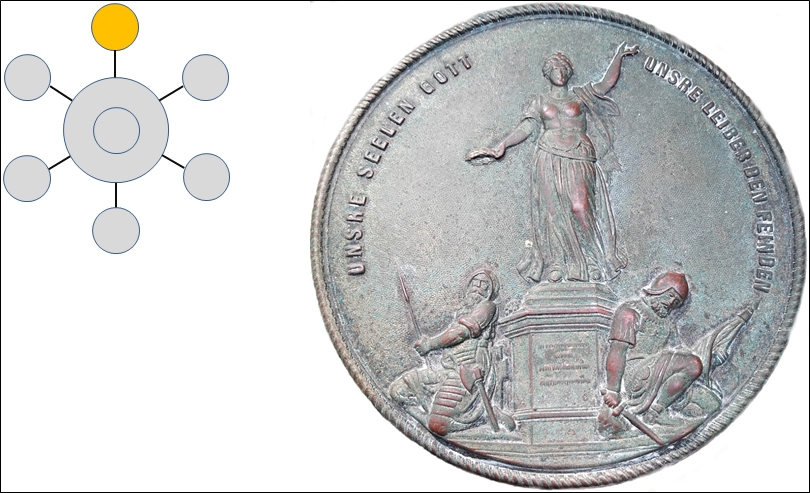
UNSERE SEELEN GOTT, UNSERE LIEBEN DER FEINDEN
OUR SOULS FOR GOD, OUR LOVE FOR OUR ENEMIES
The Battle of St. Jakob
on the river Birs was fought on August 26, 1444, during the Old Zurich War,
just outside the city of Basel, where the Council of Basel was meeting at the
time.
The opponents were on one side around 20,000 French Armagnacs and on the other
side 1,500 Confederates from the eight Old Towns, excluding the Zurichers. The
Armagnacs were supposed to advance towards Zurich to end the Confederate siege
of the city. They clashed on the Birs River in the border area of today's half-cantons
of Basel-Stadt and Basel-Landschaft.
Upon hearing of the Armagnacs' approaching the villages of Muttenz and Pratteln,
the captains of the Confederate forces encamped in front of the Farnsburg Castle
decided to undertake a raid with part of their army. During the night of August
25-26, 1,300 selected, mostly young warriors advanced through Liestal, where
they were joined by 200 newcomers from Basel-Landschaft. They attacked on the
Rhine plain, where they overran the Armagnac vanguard early in the morning.
Despite strict counter-orders, the overconfident Swiss Confederates crossed
the Birs River and encountered the 20,000-strong, battle-ready French army on
the Gundelding Field. A ten-hour clash ensued, during which the Swiss, in their
small numbers, pressed on their enemy with a huge force. Gradually, however,
due to overwhelming odds, the outnumbered Swiss troops were surrounded on all
sides. Since the Swiss Confederates, who had sought battle across the Birs River,
repeatedly and categorically refused to surrender, they were defeated - except
for 16 fugitives - finally huddled in the garden of the leper colony, under
the devastating use of enemy artillery.
News of the battle and the fearless and heroic efforts of the Swiss warriors
quickly spread throughout Europe. The French Dauphin, who commanded the Armagnac
army, abandoned his plan to advance further toward Zurich in view of the enormous
losses in his own ranks-the ratio was at least four to one, despite the presence
of Armagnac archers, some of whom were of Scottish origin, and French artillery.
The exuberant efforts of the Swiss vanguard not only prevented further bloodshed on Swiss soil in the direction of Zurich, where a Swiss army of 20,000 men was ready; The threat of an uncontrolled Armagnac mercenary army was also averted.
The battle testified to the fighting spirit of the eight ancient towns in the face of vastly superior forces and contributed significantly to the heroic myth of the Swiss Confederation throughout Europe. One long-standing legacy of this is, for example, the Papal Swiss Guard in the Vatican. The battle was further celebrated in the Swiss national anthem.
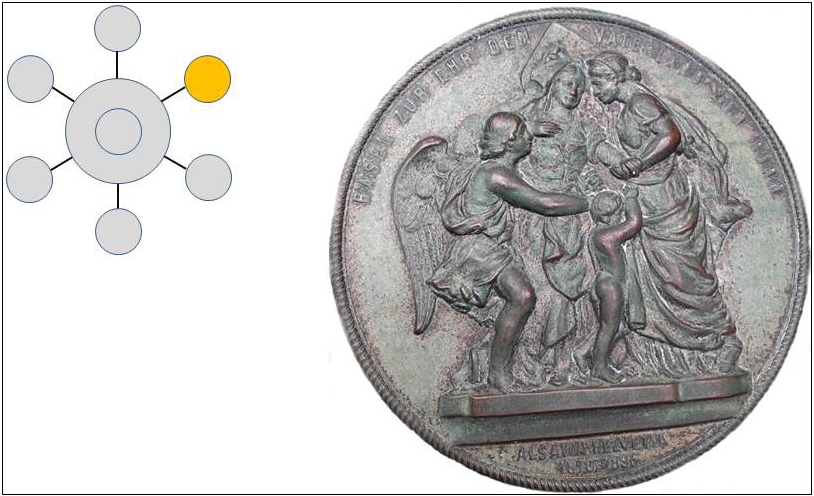
BASEL ZUM EHR DEM VATERLAND ZUM RUHM - ALSATIA HELVETICA
1870-1895
BASEL TO THE HONOR OF THE FATHERLAND TO THE GLORY - ALSACE HELVETICA 1870-1895
During the Franco-Prussian War of 1870/71, Strasbourg was besieged by German troops. On August 15, 1870, General August Leopold Karl Wilhelm von Werder (1808-1887) ordered the city to be bombarded. The bombardment hit both the French defenders and the city's civilian population. Gottlieb Bischoff (1820-1885), the Basel State Secretary, felt the urge to assist the civilian victims.
At Bischoff's suggestion, a relief committee was formed in Basel on September 4, 1870, chaired by City Council President Hieronymus Bischoff (1795-1870) and Councilor Alphons Koechlin (1821-1893). Associations with similar goals also gathered in Bern and Zurich. The three committees wanted to join forces to help the civilians in Strasbourg.
On September 8, Basel's State Secretary Bischoff, Bern's Mayor Otto von Büren (1822-1888), and the Mayor of Zurich, Dr. Melchior Römer (1831-1895), traveled to Strasbourg with the support of the Swiss Federal Council. At the German headquarters, they successfully presented their request to General von Werder.
In the weeks following September 15, the Swiss delegation succeeded in evacuating and saving many civilians from the embattled city. More than twenty years after the events, Baron Gilbert Hervé-Gruyer (1816-1893), a native of Strasbourg and resident of Montpellier, approached the Federal Council with a request for a memorial to commemorate the relief effort.
The Federal Council approved the proposal. The Federal Council also designated Basel as the location for the monument because the relief effort was initiated in that city. Baron Hervé-Gruyer succeeded in persuading the talented sculptor Auguste-Fréderic Bartholdi (1834-1904) to support his project.
Bartholdi was born in 1834 in Colmar, Alsace. As a French patriot, he felt deeply pained by the loss of Alsace to the German Empire after 1871. His Lion of Belfort, carved in 1878 into rock, became famous. It glorifies the defense of the remaining French city against the Germans during the 1870/71 war.
Bartholdi is most famous as Creator of the Statue of Liberty in New York, USA
The monument is located in front of the Basel Railway Station.
The monument depicts the guardian spirit of Strasbourg (left) entrusting the war-ravaged city (center) to the care of Helvetia (right). The weeping child represents the suffering of the population.
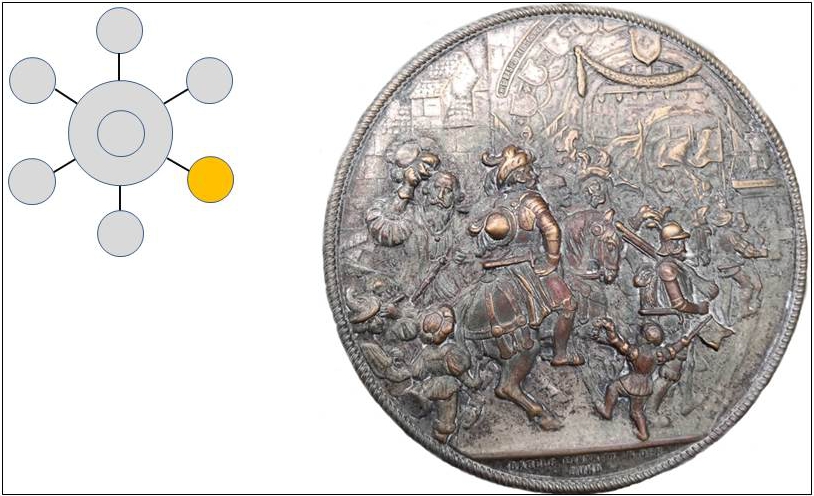
BASELS EINTRITT IN DER BUND
BASEL'S JOINING THE CONFEDERATION
Basel officially joined the Swiss Confederation as its 11th canton on July 13, 1501. This event marked Basel's official secession from the Holy Roman Empire. The move was a direct result of the Swabian War, which was resolved by the Treaty of Basel in 1499. Basel was unique in being asked to join the confederation, rather than seeking admission
Before the Protestant Reformation, Basel was ruled by prince-bishops ( the Basel coat of arms is a Bishops crosier). In the later 15th century, in the wake of the Council of Basel (1431–49), the city of Basel grew in wealth and importance. The University of Basel was established in 1459, and the city became an intellectual center of the German Renaissance in the years leading up to the Reformation. Erasmus of Rotterdam taught in Basel, and early printshops were set up by Johannes Petri and Johann Froben. In 1495, Basel was incorporated in the Upper Rhenish Imperial Circle, the bishop sitting on the Bench of the Ecclesiastical Princes.
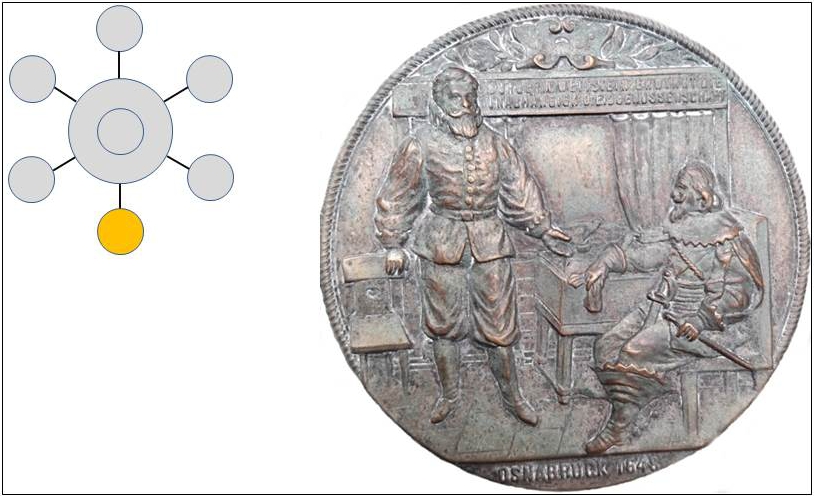
BÜRGERMEISTER WETTSTEIN ERWIRKT DIE
UNABHÄNGIKEIT DER EIDGENOSSENSCHAFT -OSNABRÜCK 1648
MAYOR WETTSTEIN ACHIEVES THE INDEPENDENCE OF THE SWISS CONFEDERATION - OSNABRÜCK
1648
Switzerland obtained independence from the Holy Roman Empire in 1648: Johann Rudolf Wettstein (27 October 1594, Basel – 12 April 1666, Basel) was a Swiss diplomat and mayor of Basel. Wettstein participated in the negotiations for the Peace of Westphalia in 1646/47 interested to gain juridical independence for the merchants of Basel from the Holy Roman Empire. Though not invited, Wettstein travelled by ship to Münster in 1646. He was also not in possession of an accreditation by the Swiss Confederacy. He was only provided with a mandate by the reformists. From the Swiss confederacy he received the official accreditation only in 1647 and after a long and skillful mediation, he achieved the official recognition of the Swiss independence from the Holy Roman Empire on the 24 October 1648 and Habsburg renunciation of all claims to Swiss government.
In memory of this achievement Basel minted a coin and the merchants of Basel donated a trophy.
During the Peasants' War of 1653, Wettstein was responsible for the public execution of seven peasant leaders. Wettstein died in Basel in 1666. He was not buried in the Münster in Basel as his wife, but in the Barfüsser Church. He is generally acknowledged as one of the most competent Swiss politicians of his era, but also as a prominent exponent of the absolutist tendencies within the Swiss Confederacy.
His career in the public service progressed with increasingly responsible positions becoming the Vogt of Farnsburg from 1624 to 1626 and of Riehen from 1626 to 1635. In 1635 he became senior guild master in the city of Basel, and by June 1645 he was elected its Mayor, which he stayed for twenty-one years.
Associated with Switzerland's independence, Wettstein's name really first became prominent around 1750, and reached its zenith during World War II, when the country's sovereignty was challenged once more.
A bridge bearing his name was built across the Rhine in Basel in 1881. In addition, a memorial-fountain, a local square and a street beside the bridge, as well as a march of the Basler Carnaval were named after Wettstein.
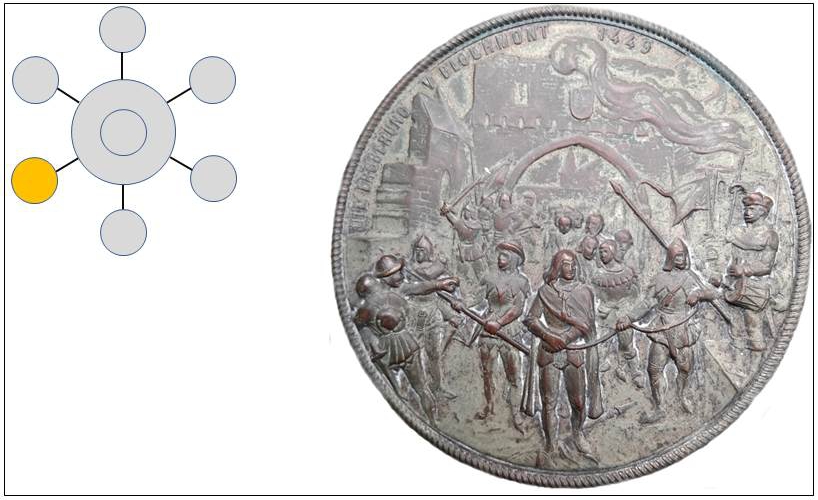
DIE EROBERUNG VON BLOCHMONT 1449
THE CONQUEST OF BLOCHMONT 1449
In the course of disputes between Basel and the Habsburgs, the Blochmont castle's lord, Hermann II of Eptingen, a follower of the Austrians, came into conflict with Basel. At that time, the Sundgau and Breisgau regions were the scene of a vicious guerrilla.
Peace negotiations had finally been agreed upon for April 6, 1449, in Breisach, and the fighting was supposed to cease during that time. However, Hermann II of Eptingen mockingly declared war on Basel via a letter of feud. He also burned down a Basel court farm near Schönenbuch. Basel sent around 40 mercenaries against Blochmont. They succeeded in setting fire to the outer bailey, killing six men, and taking ten horses. They then settled in front of the castle.
The Basel Council did not
want to jeopardize the ongoing peace negotiations in Breisach and hesitated
to besiege Blochmont. However, the Basel guilds sought to capture the castle
and exerted pressure on the Council. On April 27, 1449, the guilds finally created
a fait accompli and, after mass, hung their guild banners on their guild halls.
The Council called for calm in vain; the guilds wanted and demanded a march
against Blochmont. Finally, the Council also had the banners unfurled that evening.
Around three in the morning, the Basel troops set out to besiege Blochmont Castle.
On the second day of the siege, Rudolf von Ramstein appeared among the Basel troops to negotiate and, if possible, persuade Hermann von Eptingen to surrender. The troops were apparently not inclined to a friendly solution. Messengers also arrived from the Breisach negotiations, but they were unable to accomplish anything. The besiegers undermined the castle walls in an attempt to bring them down.
Hermann von Eptingen recognized
his hopeless situation. He also knew that he and his garrison were in danger
of being killed once the castle fell, as was common practice at the time. On
the condition that his life would be spared, he surrendered to the Basel troops
on the third day of the siege. However, the majority of them demanded his death,
so only with difficulty did a few more level-headed men manage to save him and
his men.
Before their departure to Blochmont, the Baselers had asked Bern and Solothurn
for help. A Solothurn contingent was on its way, but only arrived shortly after
the surrender. The Baselers had already decided to let Eptingen and his men
live and leave it to the Council of Six in Basel to pass judgment. Had the Solothurners
arrived a little earlier, an immediate execution would most likely have been
the order of the day.
The Baselers, however, vented their anger on Blochmont Castle, which they set fire to and destroyed. Hermann von Eptingen reportedly watched with tears in his eyes and wished he had never been born to witness such suffering. Today, only a few fragments of the castle's walls remained.
The Baslers wanted to humiliate
the defenders of Blochmont Castle. Therefore the prisoners were led by the castle
dog, "Delphin". It should be noted that Delphin, along with the other
castle dog, "Schwob," was named on a letter of vendetta from the garrison
of Blochmont to annoy the people of Basel. The fact that the formerly proud
lord of the castle, Hermann von Eptingen, had to march to Basel bound and behind
the one castle dog was a further humiliation for the nobleman.
Flanked by armed men, the dog and his lord began the march to Basel. Behind
them, bound to a long rope, followed two other noblemen and the rest of the
castle garrison. In the Spalenturm (Spalen Tower) in Basel, the prisoners anxiously
awaited the verdict of the Six, which could still cost them their lives. They
were imprisoned in the dungeons of the Spalenturm
However, eight days after
Blochmont's fall, a peace treaty was concluded with the Breisach branch, freeing
the Eptinger family and his men.
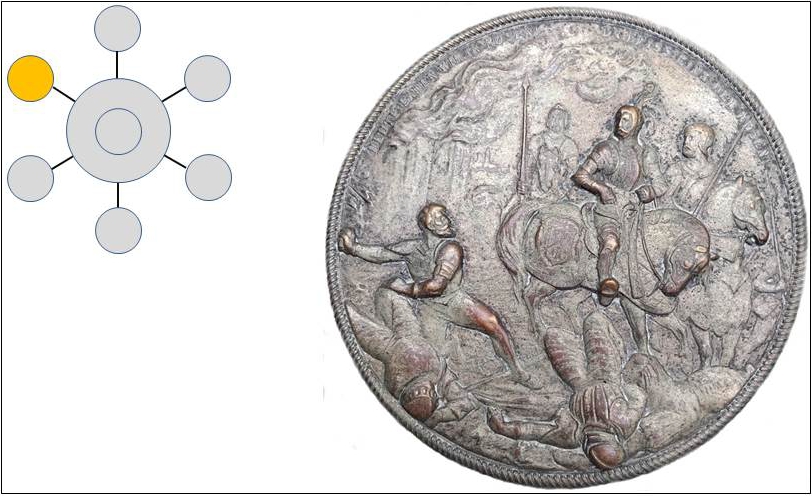
HEUTE BADEN WIR IN ROSEN - DA FRISST EINER DER ROSEN
TODAY WE BATHE IN ROSES - EAT A ROSE
This plaque is a reference
to a specific act of Swiss Bravery:
Burkhard VII. Münch (died 29 August 1444) was a knight and life peer, a
renowned member of the Landskron branch of the Münch family. His reputation
rests primarily on his death at the Battle of St. Jakob an der Birs. Burkhard's
death spelled the end of the family Münch of Landskron, which ended completely
when his brother Johann IX. died in 1461.
Being a Habsburg faithful, Burkhard rode as knight with Dauphin Louis XI and
Jean V de Bueil. He was also named by the French as Bourgeamoine. He joined
the Armagnacs in the battle against the Swiss Eidgenossenschaft as negotiator,
translator and guide. His demeanour following the Battle of St. Jakob an der
Birs is a theme in Swiss patriotic historiography.
The Battle of St. Jakob an der Birs near Basel, was fought on 26 August 1444.
The Swiss had attacked a much larger force of Armagnac mercenaries, and as the
offensive party categorically refused to surrender. They retreated to a last
stand in a small hospital of St. Jakob, where they were decimated by artillery.
As the Dauphin's translator, Burkhard was sent as negotiator to the decimated
Swiss in the hospital to offer them the chance of honorable surrender and safe
conduct. But as he rode into the hospital, and the many dead and wounded among
the Swiss he is said to have raised the visor of his helmet and mocked the Eidgenossen
in a phrase that would become famous in Swiss historiography: "I gaze out
into a rosarium, that my ancestors planted one hundred years ago"). Provoked
by this arrogant phrase, one of the dying Swiss, Arnold Schick of Uri, hurled
a rock into the open visor. The equally famous answer that accompanied the throw
was reported as: Da friss eine der Rosen! ("Here, eat one of the roses").Burkhard
fell from his saddle and was dragged from the battlefield. He died from his
wounds three days later. The Swiss refusal to surrender led to the storming
of the hospital, in which the defenders were killed nearly to the last man.
Burkhard's rather contrived utterance is given as "today we bathe in roses",
a simplification that had been current since the 18th century.
In folklore, Burkhard is
depicted as a coward who watched the battle from afar, and after the battle
came "riding among and over the mighty dead bodies", as he noted "the
agony of one of the heroes, he intended to sour his last moments with mockery,
saying "today we bathe in roses!". The dying captains anger revived
his spirits, 'eat one of the roses!' the dying hero cried, and hurled a rock
with strength and well aimed. The rock squashed his eyes, his nose, his mouth,
blind and speechless lord Burkhard sank to the ground, and suffered, until on
the third day death ended his pain, and he was not buried in the tomb of his
fathers."
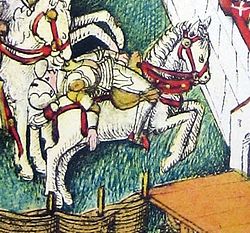
PS. Please do not ask us how to get Eurovision 2025 tickets. Even we as residents have been unsuccessful!